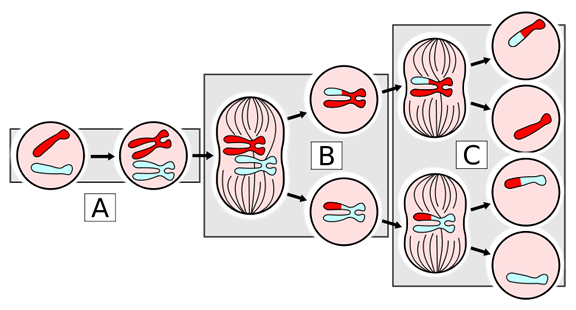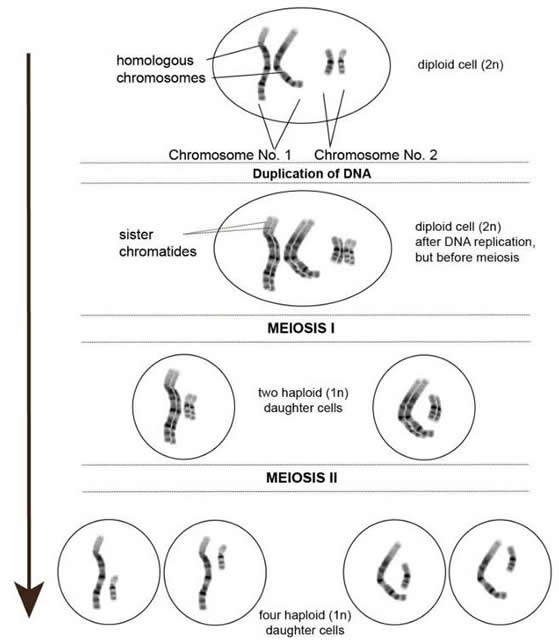Meiosis
Objectives:
- Students will be able to label the parts of the cell cycle and describe what happens in each phase.
- Students will understand and explain chromosome structure.
- Students will identify the stages of meiosis.
- Students will compare and contrast mitosis and meiosis.
- Students will be able to diagram te processes of meiosis.
Another type of cell division, meiosis, is the process used to create gametes. Gametes are the cells used to form offspring. In animals, the gametes are eggs and sperm. In plants, the gametes are ovules and pollen.
In meiosis, just like in mitosis, there is a single duplication event. That is to say, the DNA is doubled only once; in mitosis, this is how the daughter cells contain the right amount of DNA; first it is doubled and then divided in two. Unlike mitosis, which has one division, two divisions occur in meiosis, called Meiosis I and Meiosis II, which results in cells with half as much DNA. As an example, let's imagine chromosomes were apples. If your parent cell has two apples, and they are doubled, you would have four apples, so that in Mitosis when your cell divided, each cell would have 2 apples, the same as the parent. However, in meiosis, you'd split those two cells in half again, so you would have 4 cells with 1 apple each – half the number of apples in the parent cells
So, gametes contain only half of the genetic information found in an organism. That is so the male and female gametes can combine without doubling the amount of genetic material in offspring. For example, in humans, gametes have 23 chromosomes while the rest of our cells have 46 chromosomes (1 set of 23 from our mother's egg and 1 set of 23 from our father's sperm).
The following figures summarize the Process of Meiosis:

Figure 1. In this figure, the red chromosome represents the maternal while the blue represents the paternal. First, the chromosomes are duplicated, (see A. DNA replication). Then homologous chromosomes separate during Meiosis I, (see B). Then sister chromatid separates in Meiosis II, (see C) giving 4 daughter cells with half the chromosome number of the parent.

Figure 2. In meiosis, a cell undergoes two divisions: one to separate homologous chromosomes (meiosis I) and one to separate sister chromatids (meiosis II). The result is four haploid daughter cells. In the above diagram, you can see that the chromosomes are duplicated creating sister chromatids in the second picture. After meiosis I you end up with two haploid (1n) daughter cells. In the final picture, meiosis II results in four unique haploid (1n) daughter cells.
Meiosis incorporates two consecutive cycles of division: meiosis I and meiosis II. Before a cell enters meiosis, its DNA is copied, and the duplicated DNA of each chromosome is packed into two sister chromatids. This is the same as what takes place before cell division by mitosis.
Meiosis I and II are each further subdivided into prophase, metaphase, anaphase, and telophase. The first phase of meiosis I is known as prophase I.


